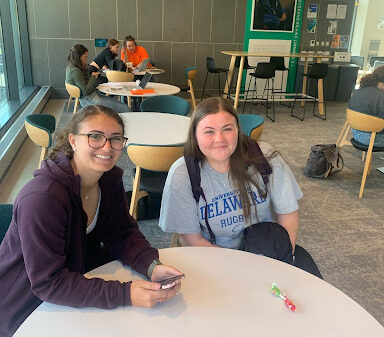The following represents the opinion of the student reporter and does not represent the views of Loyola University Maryland, the Greyhound, or Loyola University’s Department of Communication.
Everyone remembers the stop during college tours when the guide shows off the library and emphasizes their studying habits. From my tours specifically, I can recall the tour guides discussing procedures on each floor for the permitted noise levels. The floors would typically start from collaborative studying to the quietest floor at the top. Students quickly learn the type of environment they like when completing their work. While most scholars would explore this question independently, I set out to find the best study environment at Loyola to share with everyone.
As usual, I will not reveal my all-time favorite because, realistically, if I tell you my favorite, it won’t be as quiet anymore. I can’t compete for my favorite seats. If any fan or reader of mine approaches me, I might just spill.
When I need to study or complete homework, I have a variety of spots to make my own. I try to find sections composed of both extremes, in which I can complete my work and be most productive. I believe there are roughly three levels of noise: dead-quiet, “coffee house chatter”, and loud; I think “coffee house” is the best if you are not in the loop about the dead-quiet areas.
The whole seating area surrounding Starbucks is honestly a wild card as it can be loud with the Starbucks crowd and students passing by to eat and drink. One of my favorite places in Starbucks is sitting at any of the bars, which usually have a mild noise level unless at peak times. I am also a fan of the bar overhanging the Communications Department, as the hallway rarely attracts foot traffic, and I can plug in my laptop there. I also enjoy sitting at the Green and Grey Cafe and doing homework after receiving excellent customer service from the staff. These types of spots are nice because you are encouraged to eat and drink where you are working. Another thing I enjoy is that I can socialize if the opportunity arises. I do prefer to be silent when I study, but a break is always a good time to chat.
The basements of most buildings on average are absolutely quiet (aside from Sellinger). This is nice as you can rely on spots being open without any social interaction. The Student Center, Humanities porch, the Refectory, common rooms in dorms, and the outdoor patios across campus offer some of my favorite study environments. They allow for people watching, where I can be nosy and listen to people’s stories (yes, some of you are very bold dropping first and last names…crazy). Something about these places makes me feel comfortable; I like having some background noise and having the ability to pop in my headphones if I want as well. Angelica Yiannouris ‘24 is also a fan of the Humanities Refectory and shared her opinion.
“My favorite place to study is the Humanities Center, usually after 9:00 in the Refectory,” Yiannouris said. “The only issue is the lack of outlets, so come juiced up!”
After speaking with a lot of people, I’ve come to the conclusion that one of the best study spots on campus is right above Boulder 2.0. This area is called the Center for Intercultural Engagement. According to the Loyola University Maryland ALANA Services website, “Renovation to the third floor of the Student Center began in May 2018 and continued through the summer. The renovation project was completed in August 2018 and resulted in a new Center for Intercultural Engagement (formerly the CMC), as well as an updated ALANA Services and Student Activities office suite, and new additions that include the SGA Conference Room, Pride Resource Room, an additional conference room, and gender-neutral restrooms. Throughout its history, the office has served as a strong cultural and social base where all members of the Loyola community can learn about the concerns and cultures of ALANA students.”
Ani Castro ‘24 thinks it is a great study spot as well.
“Last year when I was taking Art History, I discovered the CIE and that semester I went there to get all my work done,” Castro said. “It is a great place in the middle of campus that is less social, so it forces me to actually focus on my work.” Current graduate student Connor Gorman, whilst a fan of the CIE, has a different opinion.
“I think the best one is if you can get a study room in the Fernandez Center. Those are the best because they are easier to secure than the ones near Starbucks,” Gorman said. “Boulder 2.0 is pretty neat too.” However, I also did learn that some students try not to leave their room to complete work. When I asked Emma Gruver ‘24, it seemed to me, she did not understand the reasoning for studying outside of her room.
“My favorite study spot is my own desk,” Gruver said. “Why would you leave your room?” I understand her point, since leaving your room and acquiring a spot can take around 15 to 20 minutes. Also when the weather starts to get cold, the commute to study has a diminishing return, so maybe your room could be an okay spot. Yet every student has a different room environment. Sam Label ‘24 explained why he does not study in his bedroom.
“I would do homework and study in my room, but well, it’s a mess,” Label said. “So I always do homework and study outside of my room. I think the computer labs and common rooms in dormitories such as Campion, Newman, and Avila are great spots to do work.”
Overall, I have been able to learn that the best study spot on campus is any place where you feel like you can focus. It is different for everyone. Walking around campus, you will find regulars in every location. From the Starbucks tables to the Fernandez study rooms, everyone has a preference. You’ve heard some of mine, now time to find your own.
Featured Image Courtesy of Richard Clow


















































































































